I left the launch ramp at Marysville at the peak of a midwinter high tide when flood had slowed the downstream current in Ebey Slough to a crawl. I put the outboard in neutral and eyed the swing bridge that spanned the slough a few dozen yards downstream. From my eye level, all I could see of the bottom of the bridge was a thin dark line, but that was enough. The high water left me just enough room to motor BONZO, a 19′6″ Escargot canal boat that my son had built, under the railroad’s 111-year-old swing bridge. I didn’t have to crouch to keep from hitting my head on the black, rivet-blistered steel plates, but it was good that I hadn’t put the stovepipe in place; it would have been knocked off.
The parallel concrete bridges another 100 yards downstream stood high above the slough, carrying the north- and southbound lanes of an interstate highway. The guardrails masked the cars from view, and I could see only an intermittent stream of boxy trailers hauled by semis, but the hum of engines and hiss of tires on pavement was constant. As I left the bridges behind, distance muffled the rush of traffic until it began to sound like wind-driven rain.
 Photographs and video by the author
Photographs and video by the authorAt the mouth of Ebey Slough I took advantage of a light breeze to sail the last 1-1/2 miles to the line of wrecks where I’d spend the night.
I kept to what I knew from the chart to be the main channel of the slough, but it was evident only by the absence of pilings. The separate streams of Ebey Slough, Steamboat Slough, and the Snohomish River were united by the apex of the tide. A following breeze came up, only enough to dimple the water, but I was in no rush and welcomed the chance to silence the outboard and set sail. I stepped the mast, an irregular 14′ spar I’d made from a spindly sapling by doing little more than removing the bark and drilling a couple of holes at the top for halyards, and raised the square sail. BONZO ghosted along leaving a softly pleated wake. When the wind shifted to the northwest I angled the sail and lowered the leeboard, putting BONZO’s course on a broad reach. The leeboard wasn’t meant to turn a boxy boat into an able sailer, but it does keep the bow from falling off when motoring in a crosswind.
I sailed along the edge of Possession Sound toward a breakwater made of six wrecked ships set bow-to-stern in an orderly line one-third of a mile long. With the tide up, only the ragged ends of frames and some of the diagonal planking were visible, blackened with age and bristled with the iron rods that once held the ships together. About 50′ from the line of wrecks I dropped the anchor, dragging it along under sail until the flukes set and brought BONZO to a stop.

I dropped the anchor near the line of wrecks, just visible to the right, that were scuttled to form a breakwater to protect rafts of logs tied to the pilings that surrounded the mouth of the Snohomish River. Phil Thiel, the designer of the Escargot, never intended it to be sailed, but any boat can be sailed downwind. I installed the leeboard to make BONZO more maneuverable when under power, but it also allowed her to do a bit of broad reaching. Sailing is slower than motoring, but it is quieter, so I raise the sail whenever I have a chance.
It was 3:30 p.m. and I had an hour to go before sunset—time enough to get ready to spend the night. The tide had dropped only 2’ since I’d launched and would drop another 8’ to the low at 9:00 p.m.
I tidied up, rolling the sails up on the spars, coiling line, and setting FAERIE, my folding coracle tender, on the cabin catwalk. The boat settled near the outer end of the line of wrecks, which didn’t offer as much protection as a position farther upstream. I pulled the rode and got the boat moving forward, coiling it around the port post. The anchor came up with sticky, fine black silt. I set it on deck and used my 14′ push-pole to gain a bit more ground. The depth stayed a steady 6′ until I strayed close to the wrecks and found water too deep for the pole. I’d seen photos of the wrecks during a low tide and knew there were pools of water; the current running between the ships scoured a trough. I used the pole as a paddle, moving a couple of boat-lengths away until I could push off the bottom again. I dropped the anchor again well into an area of flat sand.
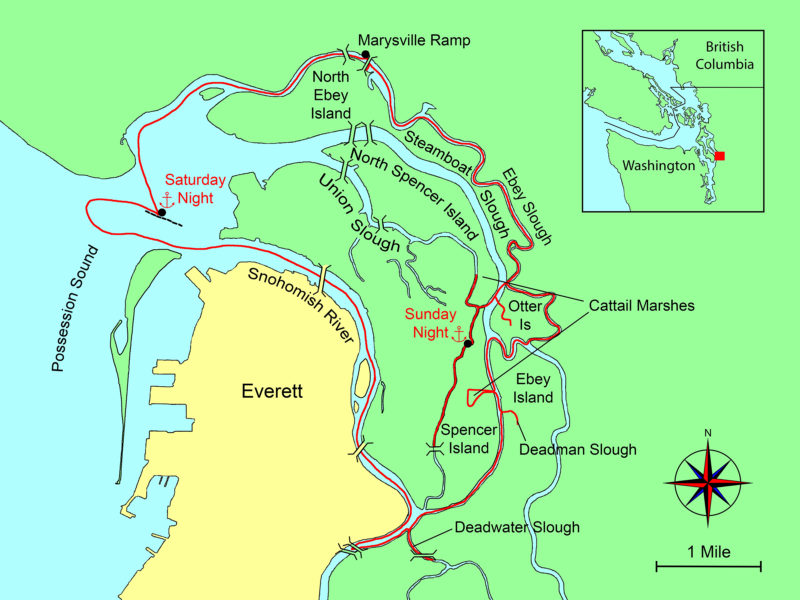 Roger Siebert
Roger Siebert.
The air chilled when the sun slipped behind the sooty streaks of clouds above the Olympic mountains to the west, so I put the chimney in place and got a fire going in the woodstove with a pot of water on top for tea.
At dusk I put on a jacket and stepped out into the cockpit to check the depth. The ebb-drawn current was no longer trailing straight back from the transom, but veered in lazy swirls as the water around the boat grew shallow. The push-pole hit bottom 2’ down. The tide chart on my phone indicated that the water level would fall another 5′, hitting low at 9:30 a.m.
After having dinner, I raised one of the windows and aimed my spotlight at the water. It was no longer green, as it had been during the day, but tan. I must have been only about 1′ deep, but I couldn’t make the bottom. I rocked in my seat…and the boat rocked with me. I was not yet aground.
At 6:30 I stepped out into the cockpit again; it was dark enough for me to see the faint cluster of the Pleiades almost directly overhead. I checked the depth with my paddle, illuminating it with my spotlight. The blade showed less than a foot of water left, though I could see only 3″ of the paddle beneath the surface, even with my spotlight. Three boat-lengths astern of BONZO a sandbar had broken the surface. I’d be aground soon.
I went back into the cabin, chilled, and opened the stove door, pulled the coals forward with a stick, and placed some cedar kindling on top. When I opened the damper, the air rushed in and a flicker of orange light glowed through the mica window.
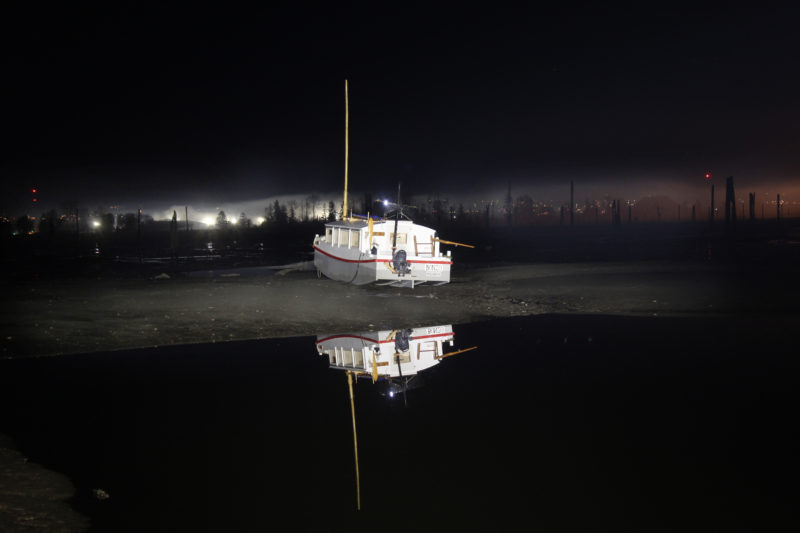
At low tide, BONZO came to rest on the sand close to the line of shipwrecks. I didn’t get to do as much exploring as I’d hoped—the mud surrounding the sand bars was far too sticky.
A few minutes later, I noticed the boat wasn’t responding to my movement and assumed BONZO was aground. I held a 2′ length of dowel at one end and let it hang vertically while eyeing the cabin door beyond it. The boat was listing only a couple of degrees to starboard—enough that I could feel it in my lower back when seated facing aft, but not so much that it would make for an uncomfortable night’s sleep.
I checked the tide chart. The curve of the graph would reach its nadir at 8:55 p.m. The point on the chart directly across from where I was now would be at 11:00 p.m. I’d be aground for four-and-a-half hours.
I heard a rattle on the cabintop that suggested the boat hadn’t stopped moving. I used my dowel as a plumb bob again. The list had doubled. With the bottom of the door lined up with the dowel, the top of the door was 2″ from its top, a list of about 5 degrees [delete: to starboard].
By the time BONZO came to rest, the top of the door was now 3″ from the dowel, a 7-degree list. While there were patches of flatter ground all around, the hull had settled in a bit of a gully in the sand. It may have been that the last of the current, seeking out the lowest ground, took BONZO with it.
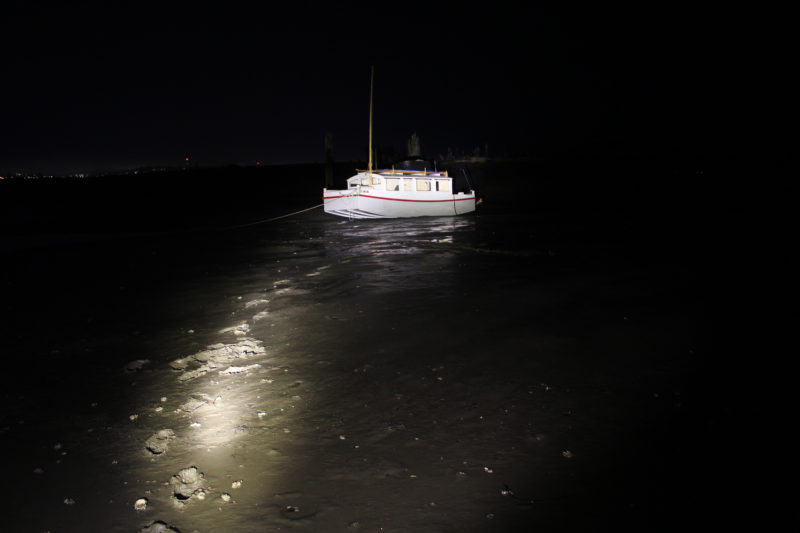
I didn’t get far from the boat before I had to turn back to get my pattens to keep from getting stuck in the mud.
I put my boots on and stepped out over the port side. The sand was firm and could easily support my weight, so I walked around on the bar that led toward the wrecks. They were, as I had seen in photos, surrounded by water that didn’t drain on the low tide. I headed the other direction, north toward the Steamboat Slough channel, though I could not see it within the 70-yard beam of my searchlight. A few yards from the boat, the sand turned to mud and I couldn’t walk without having to pull my boots up behind me. I turned back, got my 14″-square pattens out of the cockpit, and tied them on. I clomped back across the sand to the mud and tried again to walk to the river channel. The mud was extremely sticky and the rope bindings tied tight over my boots pressed painfully across my instep. The mud stuck to the bottoms of the pattens, making them quite heavy; each step became increasingly difficult.
Turning around without falling was a bit of a chore, and getting back across the mud I had just walked over was harder than it was the first time. I was relieved to get back to the sand. I took the pattens off, swished the mud off in the pool of water astern of BONZO, and put them back in the cockpit. I retreated to the cabin, got the fire going again, and boiled up more water for tea.
I went out again at about 9:15 when the tide had just turned. The sandbar to the south led right up to one of the wrecks and I easily could walk there without the pattens. The sand was soft and spongy, but my boots didn’t stick as long as I kept moving. The hull was pinned against a tall piling, and wedged in between the two, 10′ above the sand, was the barnacle-encrusted trunk of a tree with a tangle of roots on the upstream side, looking like the carcass of a giant squid.
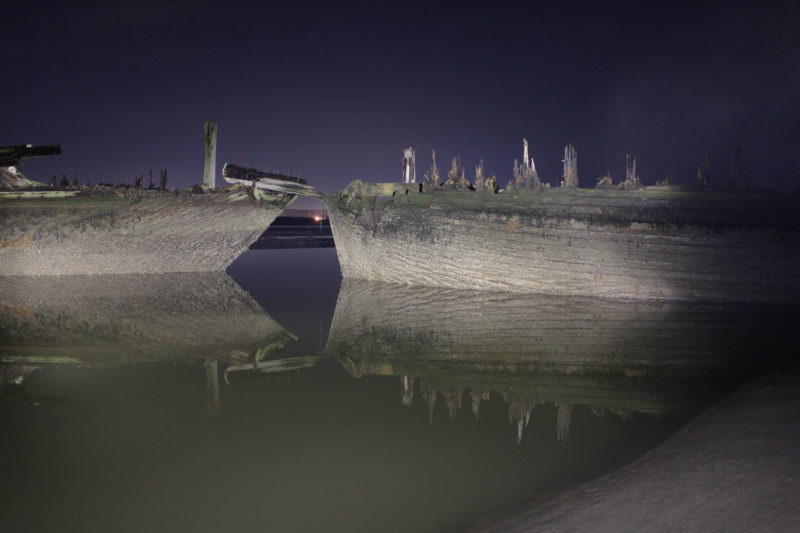
Above the reach of the high tide there was little left of the six nearly identical sailing ships that formed the breakwater. Where the hulls were submerged daily in salt water the planking was largely intact, and still held water. All through the night’s low tide I could hear trickles of water slowly dripping from the seams.
With my spotlight pointing to the west, I could see the bow of the next ship in the line of wrecks. From the side, the hulls are just a jumble of century-old timbers rotting away, but bow-on, the ship’s full curves and sweetly lined strakes were clearly visible; the beauty that was built into the hull by long-forgotten shipwrights hadn’t been diminished by tides or time.
A fog slinked in from the north, wrapping haloes around the lights of houses lining the banks of Ebey Slough. When it reached BONZO and drifted through the beam of my flashlight, it was not a gauzy haze, but a swirling sea of luminous plankton. I put one last load of wood into the stove and slipped into my bed in the forward compartment.
I woke to the sound of something knocking against the hull. BONZO was afloat and rocking, and I thought that a stick coming from upriver might have drifted under the bow. I got up and followed the sound to the cockpit where one of the oarlocks was hanging loose on its tether, rapping the hull with each swing. I set the lock in its socket. The beam of my searchlight could reach only 30 yards in the fog that had come over the tide flats. The only feature of the landscape that I could see was the single piling that stood between BONZO and the shipwrecks when I was aground.
I was awakened again at 1:15 a.m. This time I knew what the sound was: the mast rattling in the partners. I got up, crawled out onto the foredeck, pulled the mast out, and set it with the sail and oars side of the catwalk. The fog had grown thicker and I couldn’t see anything when I turned the spotlight on. All of the light bounced back as if I’d pointed it at myself. When I turned it off there was a faint, dark streak that I took to be the line of ships, but I couldn’t be sure. I tugged on the rode and found that it was quite slack. Eventually I felt some resistance and it seemed that the anchor was still holding. I crawled back in bed and turned the GPS on. It showed my speed was zero. I wasn’t drifting.
When I woke at 3:30 a.m. BONZO was still and quiet. Outside the window, what little water I could see beneath the press of the fog was glassy and calm. The tide would peak in an hour and the currents had come to a standstill. I could take advantage of the stillness and get some sleep.
The chill was getting through to me. I pulled a third sleeping bag over the others. With the additional bedding pulled up around my head I soon warmed up, and the only cold I felt was on my teeth when I breathed in.
I woke at 6:30 a.m. to the slap of wavelets under the bow that sounded like a gallon-jug of water upended, but never emptying. The fog masked the horizon; pilings 30 yards away floated in an ill-defined, colorless space. BONZO yawed gently at the end of the anchor rode, and the piling that had been several boat-lengths to the south while I was grounded drifted past. I rolled over and watched the silhouette slip by the main cabin windows. Worried that the kicked-up outboard would hit the piling, I quickly got up and moved to the cockpit. The lower unit made it past the piling with 2′ to spare.
The wind dropped as I was having breakfast, and the water soon smoothed itself like a bedsheet pulled tight. The water was not perfectly still; the ripples were just large enough to turn the soot-black reflections of the shipwrecks into sharp, horizontal shards. The biggest waves around the boat were those that radiated out from BONZO’s hull when I shifted my weight.
The high tide had passed while I was asleep, and the morning low would be an hour on the other side of sunrise. Between them the water would drop just 3’, so the currents coming out of the sloughs and river would be gentle. There was no need to get underway quickly. As the fire in the stove had gone out and the cabin was getting the edge of a chill, I loaded the stove with a few pages torn from a Harbor Freight catalog, some cedar kindling, and fir shop scraps to get another fire going.
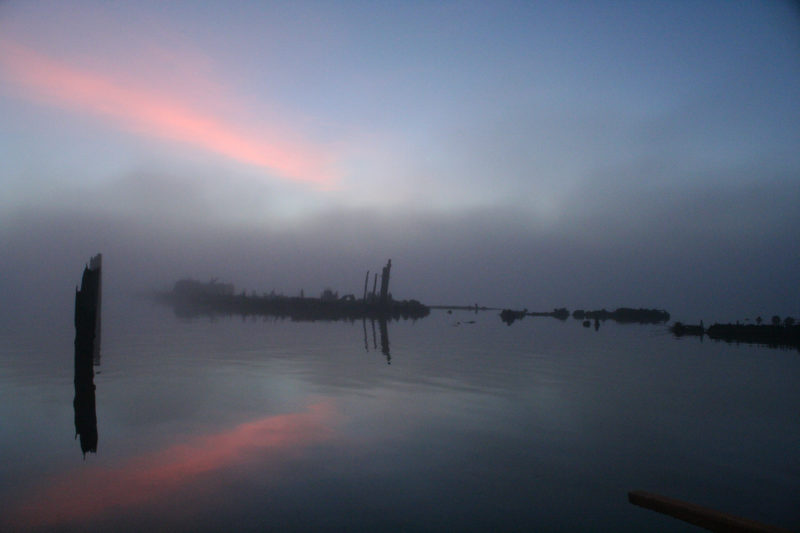
In the first light of the morning, the wrecks were all but submerged.
A single feathery cloud in the clear sky above the fog was the first to catch the morning’s rose-pink sunlight. The eastern horizon whitened and the fog lifted, revealing to the north the wooded shore I had sailed along yesterday and the industrial fringe of the city of Everett to the south. The sun’s first rays swept away the last of the enthralling uncertainties of night and fog.
The fog had covered everything with ladybug-sized beads of water. I poured a pint out of FAERIE after I had folded it up to get ready to get underway. Although the sun was shining, it was still cold, so I rigged the outboard with the yoke on the throttle and clipped the steering lines to the tiller. I started the motor, put it in gear, and took my place in the fo’c’s’le next to the control lines. I headed downstream and out into Possession Sound before turning east again for the Snohomish River.
As I approached the channel on the south side of the wrecks, I passed into an area where the waves bunched up. The chart showed an area of shallow water. I returned to the cockpit and sounded with a push-pole. Motoring along, I had a good 5’ or 6’ under BONZO but stayed in the cockpit, sounding as I went. I made a beeline for the wrecks, expecting to find the channel there. Soon the bottom was beyond the reach of my pole, and I turned upstream again.
Everett has its back to the Snohomish River, and where its banks are not covered with brush and riprap they are lined with logs piled high for sawmills, boats in bad repair, and shacks with broken windows.
There were two high concrete bridges ahead, each with mid-river piers. On a previous trip up the Snohomish, 8 miles farther upstream, my kids and I were motoring and had just passed a railroad bridge when the outboard run out of fuel. Dead in the water, BONZO was carried downstream directly at one of the bridge piers. Without time to refuel and start the motor again before an impact, my son and I paddled feverishly to keep the boat from getting wrapped around the stone bridge support. Ever since then, I’ve refueled before going under a bridge if it has been a while since I’d filled the gas tank.
I paused just shy of the bridge, stopped the motor, and fueled it. With a full tank, I started the motor and carried on. Seconds after passing under the bridge, the motor sputtered and threatened to quit. I pulled the choke and brought it back to life, steering for the bank to avoid the bridge piers. The motor didn’t sort itself out, so I brought it aboard and put my backup 2½-horse in its place.
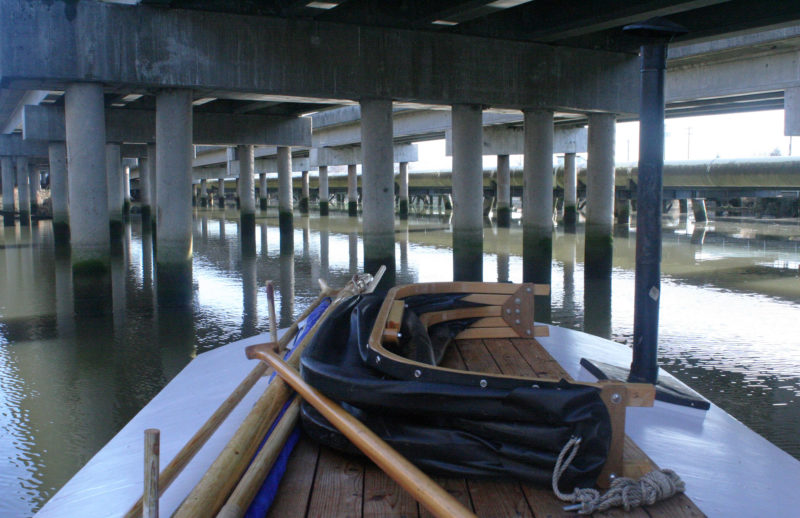
The maze of pilings supporting Highway 2 over Deadwater Slough made for an interesting slalom, but eventually led to a dead end.
I motored a few hundred yards into Deadwater Slough and cocked the motor up when I reached a maze of concrete columns that supported two roadways and a pipeline. Standing on the foredeck, I pushed off columns and paddled between them until I discovered I’d reached a dead end. With the air filled with roaring traffic overhead and the double thump of tires crossing expansion joints, I shoved my way back out, and headed for the river.
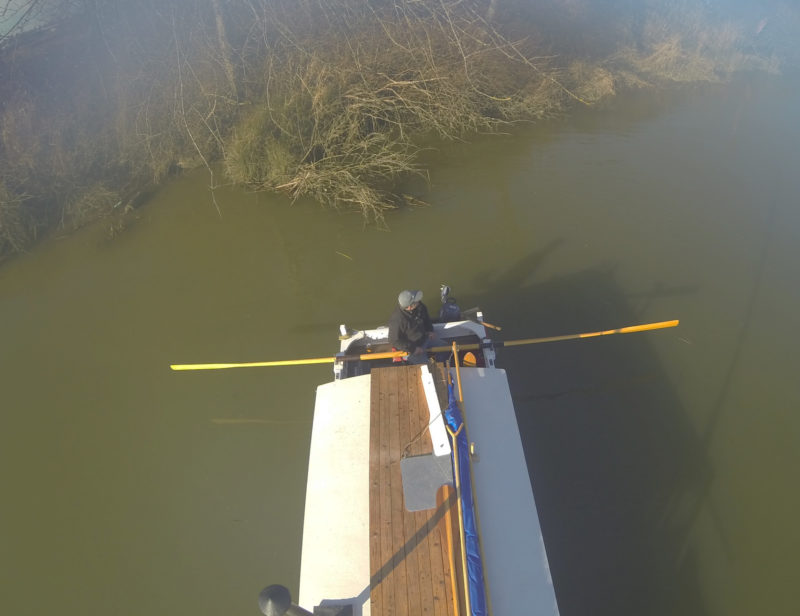
While BONZO drifted sideways with the current on Steamboat Slough, I used the oars to follow the contours of the bank.
Just a quarter mile downstream is the river’s intersection with Union Slough and Steamboat Slough. I had marked my chart with a promising place less than a half mile along Union where I could spend the night—a sandbar off to the side of the slough where BONZO could dry out again on the falling tide—but its 25-yard-wide entrance was blocked by a logjam. It was still midday, so I kicked the motor up and let the current take me sideways down Steamboat Slough, using the oars to keep away from the banks.
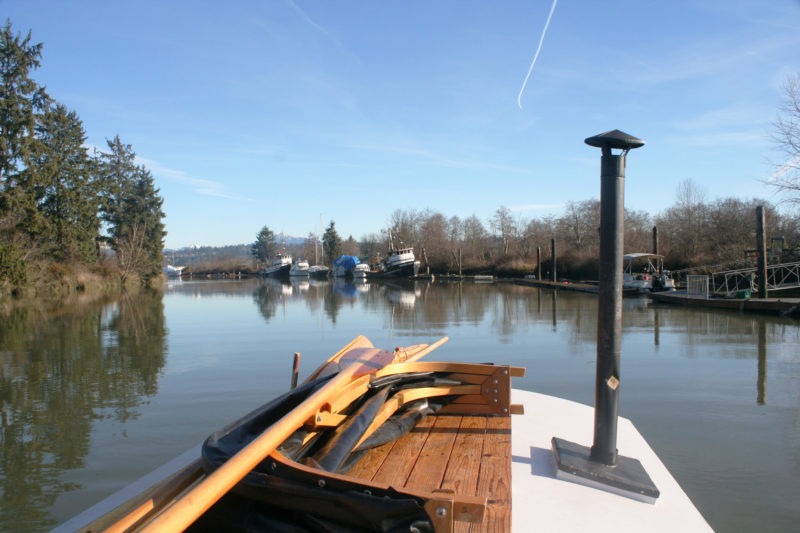
This stretch of Steamboat Slough is known as a boat graveyard, and while it is a place where many boats come to grief, this lonely stretch of the slough seems to be a place where hopes and dreams die first, and the boats waste away for years afterward.
On the right bank of the slough, stretching out for a third of a mile along the outside of the first bend, is a row of boats, many of them in bad shape. Some were wrapped in blue plastic tarps to buy time, and one lay on its side, surrounded by oil-containment boom with only its port rail and a davit above water. An old commercial fishing boat listed to starboard, its windows gone and its paint peeling away in sheets the size of letter paper. Her name, painted below the pilothouse window, was missing most of its letters, but I could read it spelled out on the bow: ELUSIVE DREAM.
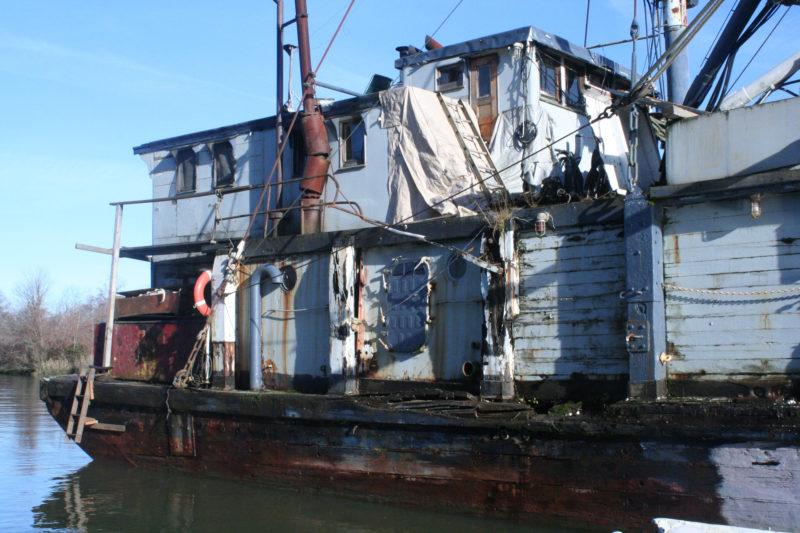
This old commercial fishing boat anchored in the middle of the slough appeared to be abandoned, but as I passed by I heard a generator throbbing deep within the hull and saw a lightbulb glowing in a window. Bearing the name MIDAS on its bow, it seems to have lost its golden touch.
I poked into Deadman Slough on the right bank, a passage a few boat-lengths wide, but there wasn’t much to see, beyond a string of surplus docks and the shell of what was once a floating office, because the levee had been built right over the slough, blocking access to the greater part of it.
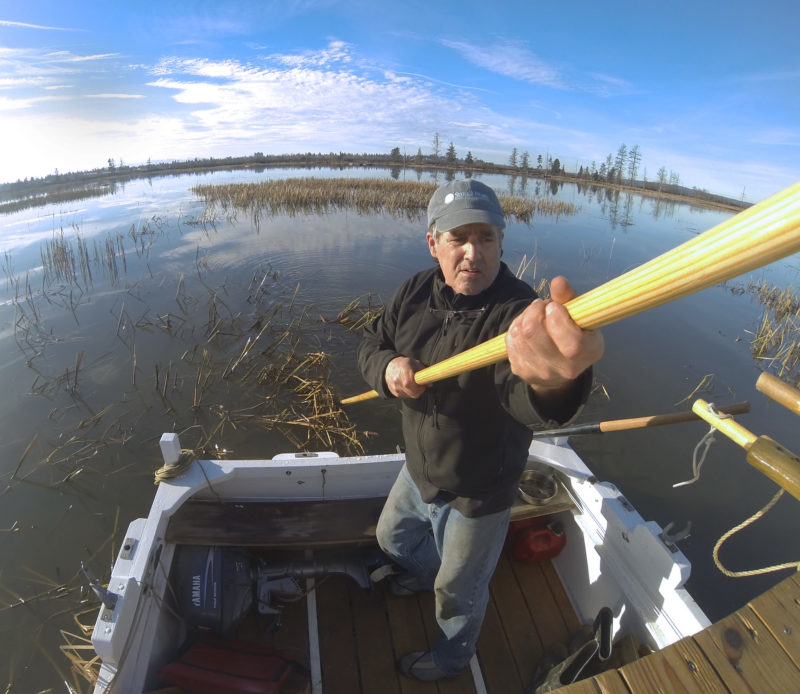
To explore a tide-flooded marsh I kicked the outboard up and used a push pole to get across the lagoon.
Another 150 yards downstream on Steamboat Slough, I motored into another opening in the bank. Water was flowing slowly out of the gap, a sign that the tide had turned, and over the next five hours it would fall a total of 11′. The passage opened onto a mile-wide cattail marsh that was almost entirely inundated except for some patches of dried reeds. I tested the depth with a push-pole at the opening, and it was about 8’ but soon became much shallower when I coasted near the brown stalks of last summer’s cattails. With the motor cocked up, I pushed BONZO through the stalks to the middle of the lagoon.
I didn’t stay long because it was drawing near 3:00 p.m., and I needed to figure out where I was going to spend the night. I wouldn’t be able to get to my first choice, the sandbar in Union Slough, because it was blocked by the logjam on one side and a footbridge on the other.
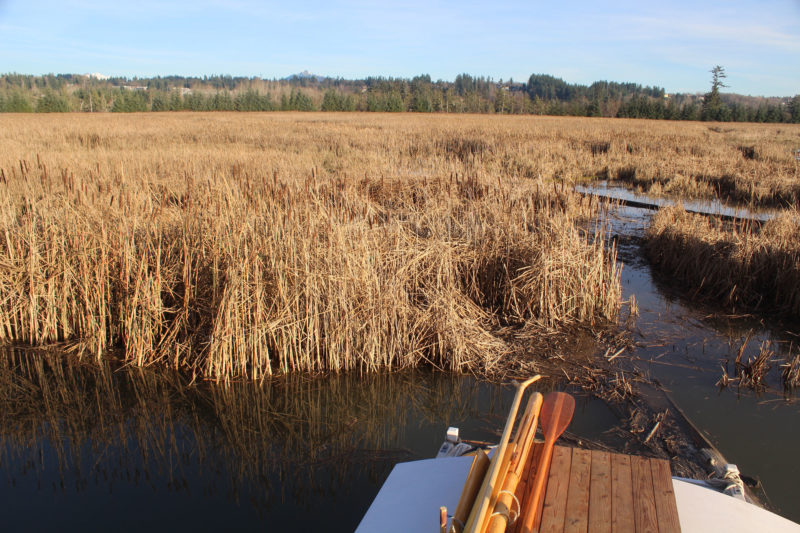
I had hoped to find a safe to anchor among the cattails, but a log blocked the channel to the patch of water I had my eye on.
I circumnavigated Otter Island on my way to an 80-yard-long passage connecting Steamboat and Union sloughs. A half mile down Union there was another potential overnight spot I had marked on my chart. I found the opening, only 10′ wide, to a channel that paralleled the slough on the other side of a narrow strip of land covered in brush. Beyond the channel was a cattail marsh a half-mile wide. Here, the marsh wasn’t flooded and the cattails stood shoulder high, topped with their corn-dog-like seed heads. The channel eventually opened up into a clear patch of water I thought might be suitable for an anchorage, but access to it was blocked by a log. I poked around under the boat with a push-pole; the channel was about 8′ deep and the bottom seemed quite irregular. I feared BONZO might end up resting at a bad angle when the tide drained the channel.
Once, a friend of mine who had cruised the sloughs in his Escargot canal boat had tried to spend a night at anchor when his bow got hung up on something. The stern went down, putting the boat at such a precarious angle that he feared the boat would swamp. He called the county sheriff in the middle of the night, and the boat that was sent out for him was able to get his boat back on an even keel.
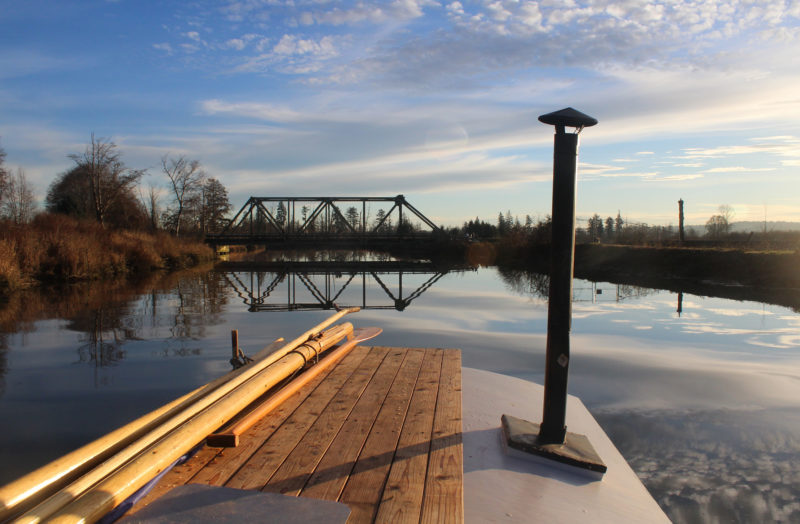
The footbridge over Union Slough limited my options for an overnight stay. On a previous trip BONZO had passed under it on a high tide with only a couple of inches to spare.
I started checking the wider parts of Union Slough itself with my handheld depth finder. Just inside of the passage to Steamboat Slough there was about 16′ of water, more than enough to float through the 10′ drop to the 9:30 p.m. low tide. I took soundings as I made my way along Union Slough, all the way to the footbridge that would block my passage. The depths varied, some offering only a few feet of water left at low, others a greater margin of safety.
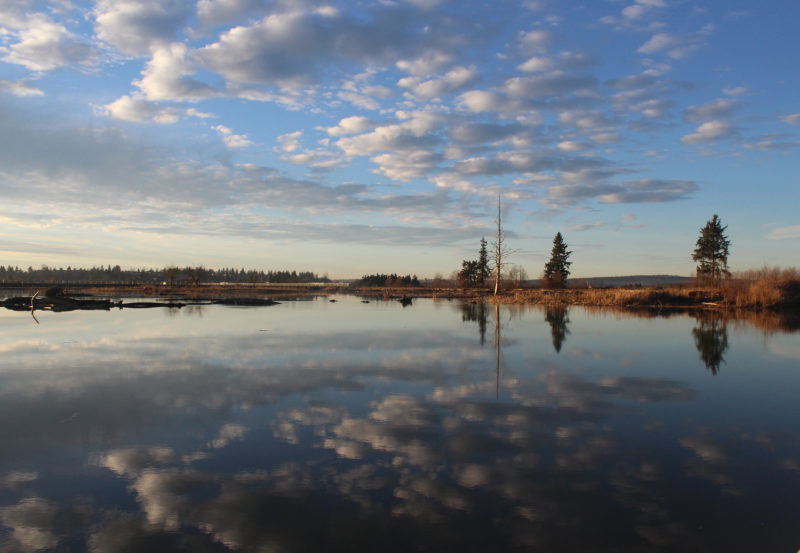
I wanted to pole across the flooded lowlands to the west of Union Slough, but I needed to pass them by to find a place to anchor and settle in for the night.
I returned to the middle of a set of four meanders where I’d found depths of 16′ and 17′ and took more soundings across the slough. The deep water seemed to span most of the channel; I’d have plenty of water under the boat at low tide.
The tide had accelerated, and the current was about 2 knots, so I motored a few dozen yards upstream, dropped the anchor, and let BONZO drift with the current set it. I watched the trees on the bank against the hills in the distance, and when the anchor buried itself it was quite clear that the downstream drift had come to a quick end. I took the 14’ push-pole and swept the area under and around the boat looking for anything projecting upward from the bottom.

When BONZO was first launched we had 13 people aboard and everyone had a place to sit. With the cabin to myself, I had room to spread out. My bed is in the bow, just beyond the wood stove behind me
It was 4:30 p.m. and the sun was setting over Everett. Throughout the evening I kept watch on the banks as they were exposed by the falling tide. They were muddy but steep, as I had guessed and hoped. I’d have plenty of room in the middle of the slough to keep afloat at low water. At 8:30 p.m., with an hour to go and only inches left to drop, I still had 9.2’ beneath the hull.
As the tide dropped, and the ebb pulled the water from the slough, there was a steady parade of driftwood marching downstream. Broken branches scratched along the bottom and low-floating logs knocked on the hull from bow to stern.
At 8:30 p.m. I looked around with my searchlight and could see only the banks to either side, but nothing up- or downstream, because a fog had filled the little canyon of the now half-empty slough. I checked the depth and still had 9′ beneath the boat with only 6″ left to go until low. As I was reaching over the transom I was startled by a splash sounding equal to a concrete block being dropped overboard. I could make out the silhouette of a beaver upstream, his head at the apex of an arrowhead wake. I aimed my light at him and he slapped his tail again and disappeared.
I turned in, feeling I could sleep through the night without having to check on the water level. The tide would be rising, and even if BONZO kited over to one of the banks, the tide would lift the boat free.
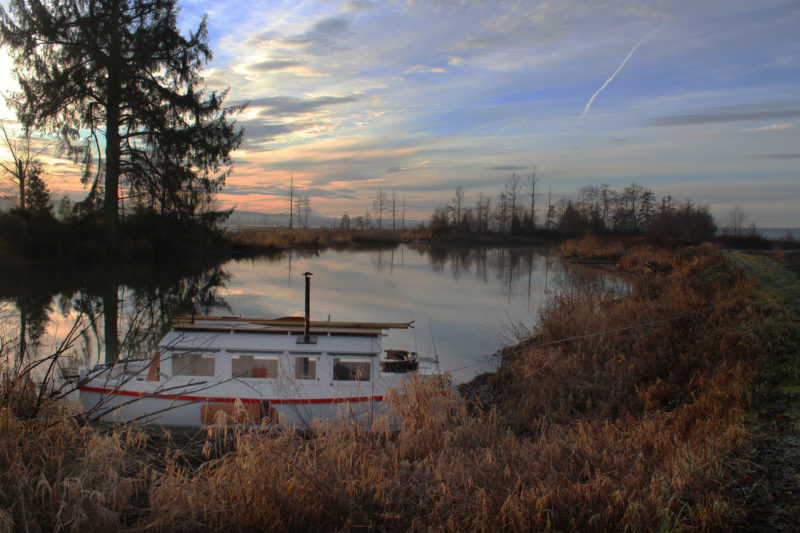
With a clear view of the Cascade Mountains, even Mt. Rainier far to the south (behind the two bare trees above the stovepipe), the morning was off to a good start until I tried weighing anchor.
I got through the night without waking up every couple of hours to check on the boat. It was a bit after 6:00 a.m. and still dark, but BONZO was afloat in midstream and the slough was filled back up to the brim.
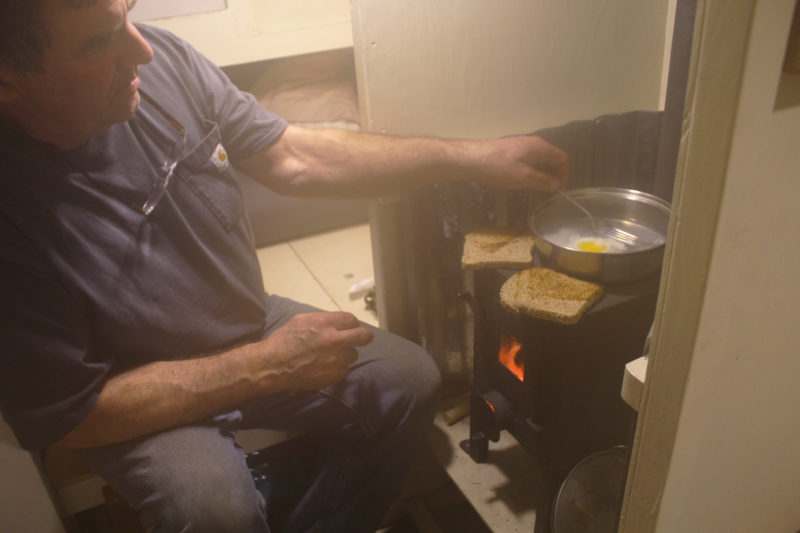
On this cold morning, sitting by the wood stove cooking breakfast was the place to be.
I got a fire going in the stove and set on a pan of water for poached eggs and bread for toast. After putting the cabin in order, I went to the cockpit and got the outboard ready to start. I moved across the cabin roof to the foredeck and hauled the anchor rode in, coiling it on the starboard corner post as I brought it in. BONZO moved forward, against the current, and soon the rode was nearly vertical. I pulled, but the anchor didn’t break free. I hauled as hard as I could, but it only pushed the bow deeper into the water.

My anchor was stuck under a log submerged in mid channel just beyond BONZO. Pulling from this bank and the far bank didn’t budge it.
I spent the next hour and a half doing everything I could think of to recover my trusted stainless-steel anchor. I brought the rode aft, hitched it to a post, and motored at full speed upstream. I tied the end of the rode to a fender and cobbled together an anchor retrieval device with things I had on board. I made a ring of stiff, vinyl-coated chain that I hoped would slide down the rode, anchor chain, and the anchor’s shank. I tied a spare rode to the chain, and sent it down to get the loop over the anchor shank to pull its fluke free. That didn’t work—the chain never got a purchase on the anchor. I put BONZO ashore on the right bank, the left bank, upstream, and down, dug my heels in, and pulled in every direction. It was clear that I had hooked a heavy log.
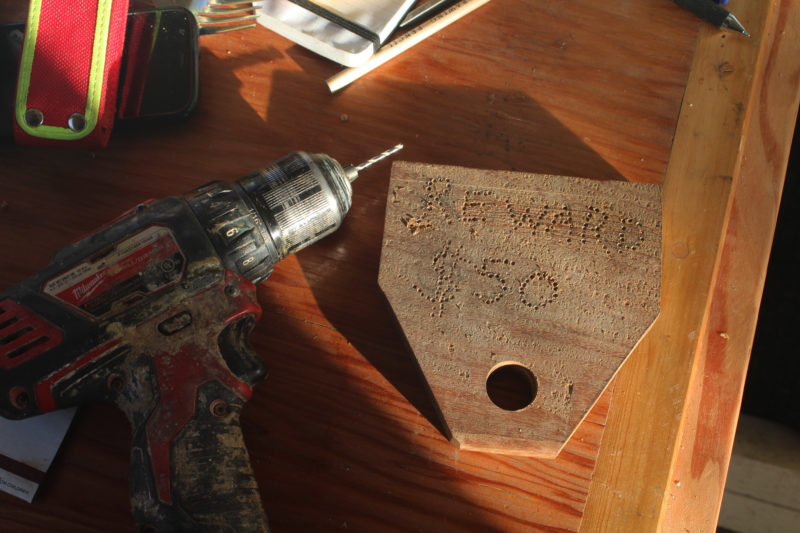
I tried everything I could think of to get my anchor back, but I had to give up and hope “REWARD $50” drilled into a piece of hardwood that I tied to the anchor chain would someday get my anchor back to me.
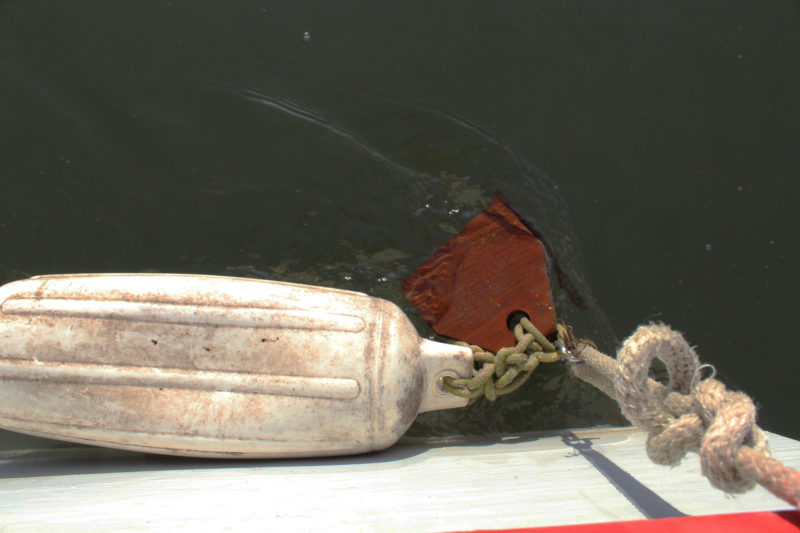
After spending the best part of the morning trying to retrieve my anchor, I gave up, but rather than let it be lost for good, I tied the chain to a fender and a piece of wood with my phone number on it.
The best I was able to do was to get the end of the chain to break the surface. The anchor was a good one, and I was reluctant to give up on it, but I had run out of ideas. I decided I’d write my phone number on one of my older fenders, then leave it tied to the chain. I didn’t have a permanent marker on board, but I did have a cordless drill and bits. In the firewood was a scrap of ipe decking with a 3/4″ hole through it. With a small bit chucked in the drill I made a series of holes spelling out “REWARD $50” on one side, and my phone number on the other side. I tied the fender and the wood to the last two links in the chain, then cut the rode. The fender drifted a few feet aft with only one end breaking the surface of the water and then the current pulled it down and out of sight.
BONZO drifted downstream, and since she stayed in the middle of the slough through the meanders, I just let her drift.
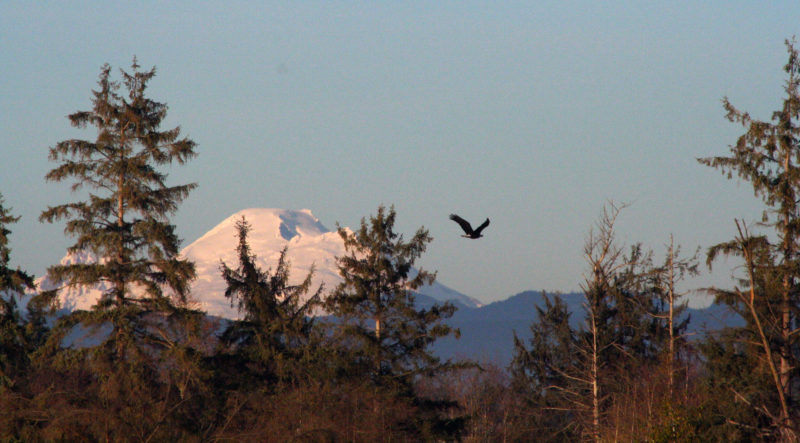
Mt. Baker loomed over the sloughs. In my 20s I had twice climbed the left flank and looked out over the Everett waterways from the summit. A bald eagle took to the air when BONZO motored beneath his perch.
When I reached the junction with Steamboat Slough, I motored over to Otter Island where I found a narrow opening in the west side of the island. I poked BONZO’s bow in and cut the engine. I poled around the first bend, thinking the water would be shallow in a passage barely wide enough to turn the boat around, but the bottom was at an awkward depth for using the pole, so I switched to sculling with an oar set in a lock mounted on the transom.
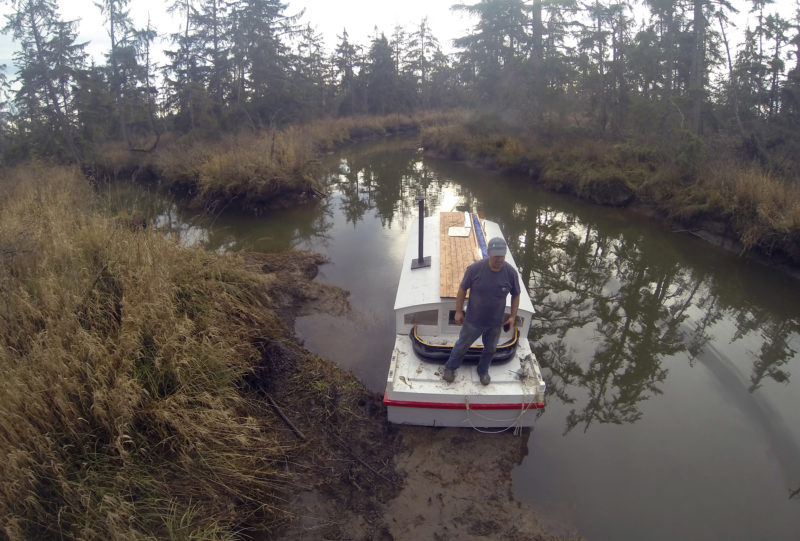
The narrow waterway in Otter Island was an enchanting place to explore, but I didn’t stay long, worried I’d get trapped by a falling tide.
I sculled the bends in this little slough for about 300 yards, never able to see more than a few boat-lengths ahead or behind. The banks were overhung with grass, and the trees closest to the water were leaning over it. The blade of the oar struck submerged roots reaching out from the mud beneath the grass. I was halfway through a hairpin turn to port before I saw a log bridging the banks, a foot above the water. I grabbed a paddle and dug in over the port quarter to bring the boat to a stop.
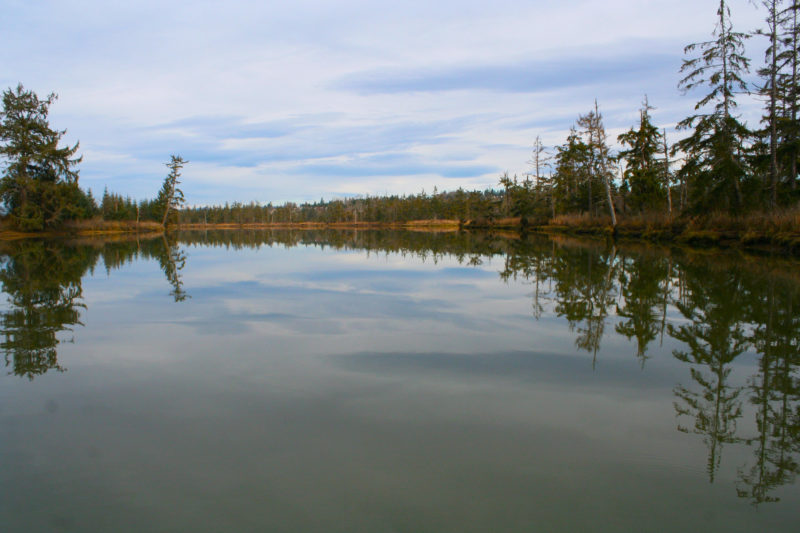
As I sat on the cabin top I watched the ripples spread out across the slough when I rocked the boat. I could still see them when they reached the lower trunk of the tree leaning over the far bank to the left.
I got BONZO turned around and sculled back to Steamboat Slough. There wasn’t a breath of wind on the water, and barely any current, so the sky, clouds, and trees were mirrored in the water. I ate lunch sitting on the catwalk as the shore 15’ off the stern inched by. I rocked the boat and watched the ripples radiate from the hull. They warped the reflections of the clouds, and then turned the images of the treetops ragged. I could still see the effects of the ripples 200 yards away when they reached the reflection of a lone fir tree leaning the over the opposite bank of the slough. In the moment before they disappeared, the image of the trunk had the look of a finely threaded machine screw.
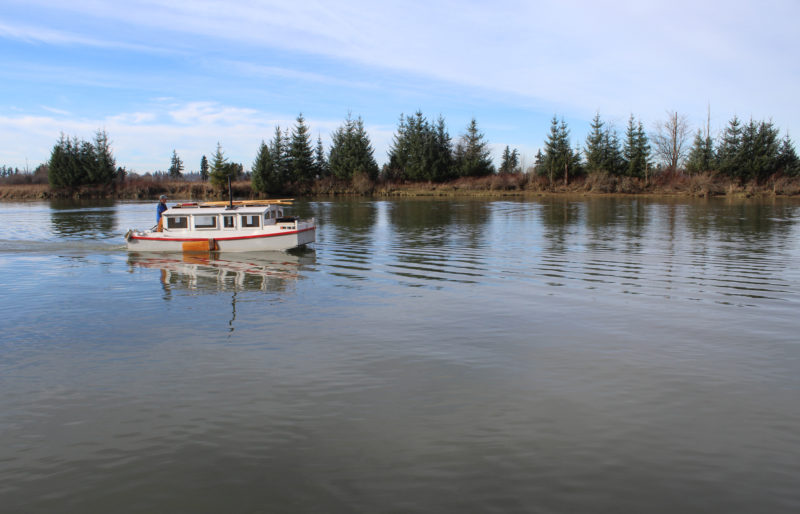
On the afternoon of my last day, I had Steamboat Slough to myself. The water had been so still that I regretted making a mess of it by getting underway.
I climbed down into the cockpit, started the motor, and steered for an opening in the bank to starboard where the Steamboat Slough made a tangential touch to a sharp bend in the Ebey Slough. The Ebey Slough, at 50 yards wide—half the width of Steamboat—curled around North Ebey Island in jigsaw-puzzle curves.
In a little over an hour, BONZO was back on the trailer, doing 50 miles an hour over the bridges we’d passed under at less than a tenth of that speed. The noise of engines and tires on pavement was constant; I missed the distance that made it sound like wind-driven rain.![]()
Christopher Cunningham is the editor of Small Boats Monthly.
If you have an interesting story to tell about your adventures with a small boat, please email us a brief outline and a few photos.
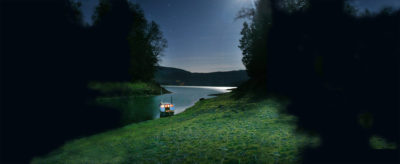
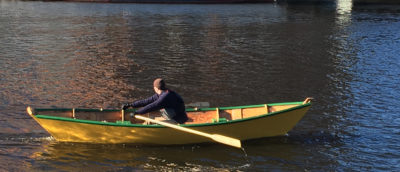
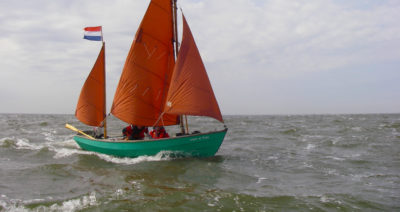
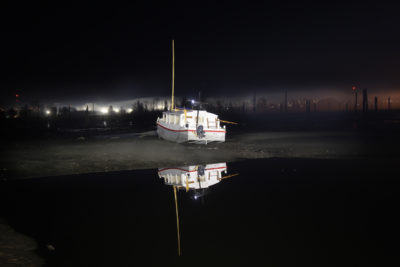
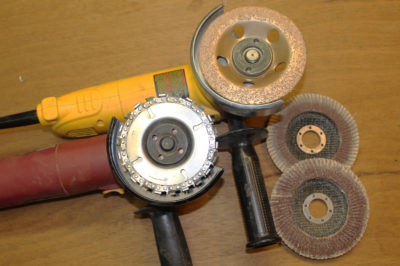
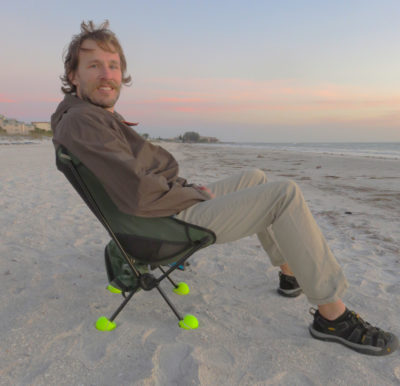
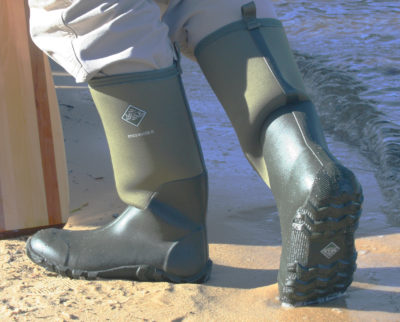





Very nice trip. I was seeing some of those sloughs a couple of weeks ago when I took a road trip up the Skagit to see the eagles.
I thought of taking my SCAMP, NODDY, on such a voyage, mast down most of the time and using oars or my Torqeedo. You’ve given me new insight and inspiration.
Thanks
A wonderful solo messabout! Has me in mind of Ransome’s book Secret Water. Well done, and thank you for sharing.
Hi, Chris. An awesome trip, it made me feel as if I was in the boat with you enjoying the solitude of the occasion. It so reminded me of being brought up on the salt marshes and tributaries on the coast of Northeast Massachusetts. At 14 years old I had cut the metal roof out of an abandoned 1946 Chevy, rolled its edges, nailed and tarred in boards on the ends to add a stern and bow. A soda box to sit on and a pole and paddle then would turn the miles of salt marsh into my oyster, as we would say. At high runner tides I could go for miles and as the tides went down I was forced to the creeks and rivers. Thanks for bringing back the memories.
Great article, Chris. It makes me want to get back out on the water, except for that pesky 25-degree temp and 20-mph wind. I felt your pain with the anchor. I use a beautiful stainless-steel anchor my father-in-law gave me a few years ago before he passed away. Its obviously irreplaceable. I’ve thought about getting a cheap one to use on the boat and just display the SS one.
Curt White
Another Proud Escargot Owner
A lot of anchors, the one I lost included, have a hole or an eye on the shank down close to the fluke end. Having never lost an anchor before, I didn’t pay much attention to that feature. It’s an attachment point for a tripping line. When I replace my stainless-steel anchor—or get it back from someone collecting the reward—I’ll put a shackle in that hole and attach a line that has a float on its other end. Pulling that line instead of the rode will back the anchor out of a jam.
Good article. Never having been in your part of the country, I was able to see it just by reading the story. I look forward to reading more.
Chris, I have explored that area a little bit. The Northwest Steam Society does a cruise once a year in the Snohomish River and down Steamboat Slough where we raft up for lunch. Excursions into the cut in Otter Island is the high point of the trip, conjuring up images of the AFRICAN QUEEN and Humphrey Bogart as Charlie Allnut. The derelict boats/ships in Steamboat are truly amazing: “Somebody actually lives on that?”
Chris, as an interested antipodean (Australian) I was looking up the location of your voyage on Google Earth and observed the wrecks in Possession Sound. I had recently seen a TV program about an ill-fated scheme to build a fleet of wooden cargo steamers to ferry freight to Europe when the USA entered World War 1 in 1917 and since 6 or 7 of the wrecks appear identical (about 270′ x 45′ scaled) I did some more research and am of the opinion that these are indeed some of these ships. Apparently the majority were built to a “Ferris” design, which seems to match the scaled dimensions. A large number were scuttled and burned to the waterline at Mallows Bay in the Potomac River, Maryland. These are known as the “Ghost fleet of Mallows Bay” and are now a nature reserve. A bit of useless trivia. Thanks for your always interesting stories.